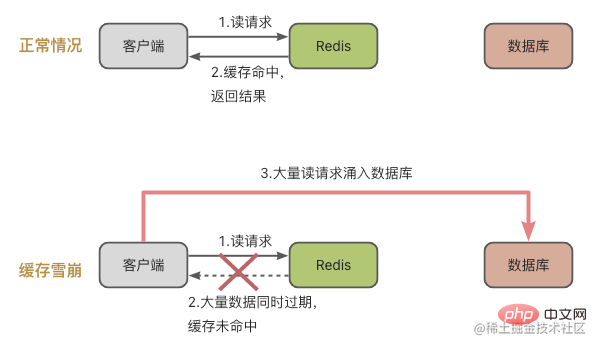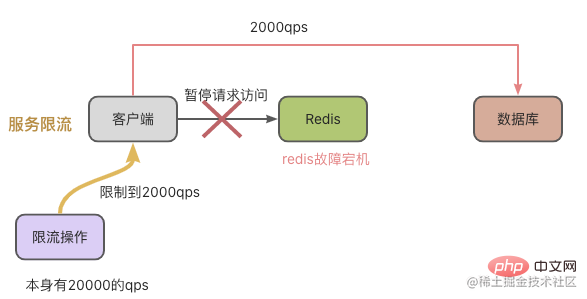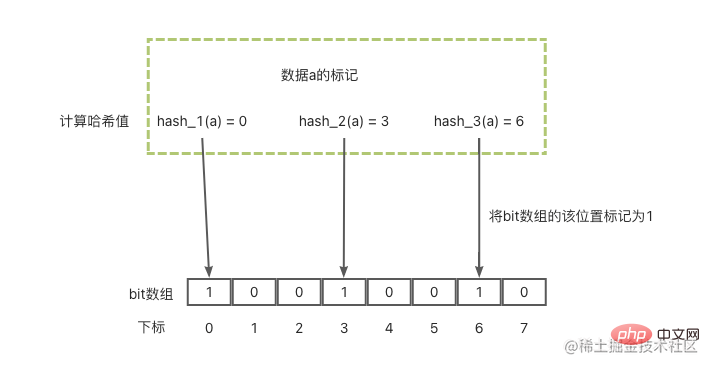一文搞懂redis緩存雪崩、緩存擊穿和緩存穿透
這篇文章為大家帶來了關於Redis的相關知識,其中主要介紹了關於緩存雪崩、緩存擊穿和緩存穿透的相關內容,下面一起來看一下,希望對大家有幫助。

推薦學習:Redis影片教學
#關於Redis的高頻問題,快取雪崩、快取擊穿和快取穿透一定少不了,相信大家在面試中都被問過類似的問題。為什麼這些問題一直很熱門呢?因為我們在使用Redis快取時,這些問題都是很容易遇到的。接下來我們就來看看這些問題都是怎麼產生的,對應的解決方案都有哪些吧。
快取雪崩
首先來看看快取雪崩,快取雪崩的概念就是:大量的請求沒有在Redis快取中處理,導致請求都湧入到資料庫中,然後資料庫的壓力劇增。
造成快取雪崩的原因可總結為2個:
- 快取中有大量的資料同時過期,這樣此時大量的請求都懟到資料庫了。
- Redis快取執行個體發生故障了,無法處理大量請求,也會導致請求都跑到資料庫去了。
先來看看第一個場景:快取中大量的資料同時過期問題。
快取中大量的資料同時過期
結合圖例來看,就是大量的資料在同一時間過期,然後此時又有很多的請求要讀取這些資料。當然就會發生緩存雪崩,導致資料庫壓力劇增了。

大量資料同時過期的解決方案
應對大量資料同時過期問題,通常有2種方案:
- 資料過期設定增加隨機時間:也就是用expire指令設定過期時間時,增加一個隨機的時間,例如資料a是5分鐘過期,在5分鐘的基礎上隨機增加10-120秒時間。這樣就能避免大量數據同時過期。
- 服務降級:也就是發生快取雪崩時,(1)若存取的不是核心數據,當沒有快取命中時,不去資料庫了,直接返回預先設定好的信息,例如空值或錯誤資訊;(2)當存取的是核心數據,快取未命中時,允許去資料庫查詢。這樣就將不是核心資料的請求都拒絕懟到資料庫了。

看完了大量資料同時過期的狀況,再來看看Redis快取實例故障的情況。
Redis快取實例故障導致的快取雪崩
這種情況下,Redis無法處理讀取請求了,請求自然就懟到資料庫了。
通常來說,應對這種情況,我們也有2種方式:
- 在業務系統中做好服務熔斷/請求限流。
- 事前預防:建立Redis高可靠集群,例如主從集群的主備切換。
服務熔斷,也就是當Redis發生故障時,暫停請求對快取系統的存取。等到Redis恢復正常了再開啟請求存取。
這種方式我們需要對Redis或資料庫的運作狀態進行監控,例如MySQL的負載壓力、Redis的CPU使用率、記憶體使用率及QPS等。當發現Redis實例快取雪崩了,就暫停服務。
這種情況能有效放置大量請求對資料庫造成壓力。但是會暫停請求訪問,對業務端的影響很大。

因此,為了減少對業務端的影響,我們可以使用請求限流方式,控制QPS,避免過多的請求懟到資料庫。例如下面圖例,本身有2萬每秒的請求,但因為Redis故障宕機了。我們限流作業將qps降到2千每秒,資料庫處理2000的qps還是沒問題的。

快取擊穿
快取擊穿就是指個別存取頻繁的熱點資料無法快取命中,然後請求都湧入資料庫。它經常會在熱點資料過期時發生。

對於快取擊穿問題,我們知道這些都是被存取非常頻繁的熱點數據,處理方式就簡單粗暴了,直接不設定過期時間了。等熱點資料不頻繁存取再手動處理即可。
Cache Penetration
Cache avalanche is something special. It means that the data to be accessed is neither in the Redis cache nor in the database. When a large number of requests enter the system, Redis and the database will be under tremendous pressure.

There are usually two reasons for cache penetration:
- The data is accidentally deleted, resulting in no data in the cache and database. However, the client doesn't know this and is still requesting frantically.
- In the case of malicious attacks: that is, someone is targeting you to check for data that is not available.
For cache penetration, you can refer to the following solutions:
- is to set a null value or default value for the cache value. For example, when cache penetration occurs, set a null value/default value in the Redis cache. Subsequent queries for this value will directly return this default value.
- Use Bloom filter to determine whether the data exists and avoid querying from the database.
- Perform request detection on the front end. For example, filter some illegal requests directly on the front end instead of sending them to the back end for processing.
The first and third points are easier to understand and will not be described here. Let’s focus on the second point: Bloom filters.
Bloom filter
The Bloom filter is mainly used to determine whether an element is in a set. It consists of a fixed-size binary vector (can be understood as a bit array with a default value of 0) and a series of mapping functions.
Let’s first take a look at how the Bloom filter marks a data a:
- In the first step, multiple mapping functions (hash functions) will be used. Each Each function will calculate the hash value of this data a;
- In the second step, these calculated hash values will be modulo the length of the bit array respectively, so that each hash value on the array is obtained position;
- The third step is to set the positions obtained in the second step to 1 on the bit array respectively.
After these 3 steps, data labeling is completed. Then you need to query the data when it is not there:
- First calculate the multiple positions of this data in the bit array;
- Then check these positions of the bit array respectively bit value. Only if the bit value of each position is 1, it means that the data may exist, otherwise the data must not exist.
Combined with the picture below, the basic principle is like this.

Recommended learning: Redis video tutorial
以上是一文搞懂redis緩存雪崩、緩存擊穿和緩存穿透的詳細內容。更多資訊請關注PHP中文網其他相關文章!

熱AI工具

Undresser.AI Undress
人工智慧驅動的應用程序,用於創建逼真的裸體照片

AI Clothes Remover
用於從照片中去除衣服的線上人工智慧工具。

Undress AI Tool
免費脫衣圖片

Clothoff.io
AI脫衣器

Video Face Swap
使用我們完全免費的人工智慧換臉工具,輕鬆在任何影片中換臉!

熱門文章

熱工具

記事本++7.3.1
好用且免費的程式碼編輯器

SublimeText3漢化版
中文版,非常好用

禪工作室 13.0.1
強大的PHP整合開發環境

Dreamweaver CS6
視覺化網頁開發工具

SublimeText3 Mac版
神級程式碼編輯軟體(SublimeText3)
 redis集群模式怎麼搭建
Apr 10, 2025 pm 10:15 PM
redis集群模式怎麼搭建
Apr 10, 2025 pm 10:15 PM
Redis集群模式通過分片將Redis實例部署到多個服務器,提高可擴展性和可用性。搭建步驟如下:創建奇數個Redis實例,端口不同;創建3個sentinel實例,監控Redis實例並進行故障轉移;配置sentinel配置文件,添加監控Redis實例信息和故障轉移設置;配置Redis實例配置文件,啟用集群模式並指定集群信息文件路徑;創建nodes.conf文件,包含各Redis實例的信息;啟動集群,執行create命令創建集群並指定副本數量;登錄集群執行CLUSTER INFO命令驗證集群狀態;使
 redis數據怎麼清空
Apr 10, 2025 pm 10:06 PM
redis數據怎麼清空
Apr 10, 2025 pm 10:06 PM
如何清空 Redis 數據:使用 FLUSHALL 命令清除所有鍵值。使用 FLUSHDB 命令清除當前選定數據庫的鍵值。使用 SELECT 切換數據庫,再使用 FLUSHDB 清除多個數據庫。使用 DEL 命令刪除特定鍵。使用 redis-cli 工具清空數據。
 redis怎麼讀取隊列
Apr 10, 2025 pm 10:12 PM
redis怎麼讀取隊列
Apr 10, 2025 pm 10:12 PM
要從 Redis 讀取隊列,需要獲取隊列名稱、使用 LPOP 命令讀取元素,並處理空隊列。具體步驟如下:獲取隊列名稱:以 "queue:" 前綴命名,如 "queue:my-queue"。使用 LPOP 命令:從隊列頭部彈出元素並返回其值,如 LPOP queue:my-queue。處理空隊列:如果隊列為空,LPOP 返回 nil,可先檢查隊列是否存在再讀取元素。
 centos redis如何配置Lua腳本執行時間
Apr 14, 2025 pm 02:12 PM
centos redis如何配置Lua腳本執行時間
Apr 14, 2025 pm 02:12 PM
在CentOS系統上,您可以通過修改Redis配置文件或使用Redis命令來限制Lua腳本的執行時間,從而防止惡意腳本佔用過多資源。方法一:修改Redis配置文件定位Redis配置文件:Redis配置文件通常位於/etc/redis/redis.conf。編輯配置文件:使用文本編輯器(例如vi或nano)打開配置文件:sudovi/etc/redis/redis.conf設置Lua腳本執行時間限制:在配置文件中添加或修改以下行,設置Lua腳本的最大執行時間(單位:毫秒)
 redis指令怎麼用
Apr 10, 2025 pm 08:45 PM
redis指令怎麼用
Apr 10, 2025 pm 08:45 PM
使用 Redis 指令需要以下步驟:打開 Redis 客戶端。輸入指令(動詞 鍵 值)。提供所需參數(因指令而異)。按 Enter 執行指令。 Redis 返迴響應,指示操作結果(通常為 OK 或 -ERR)。
 redis怎麼使用鎖
Apr 10, 2025 pm 08:39 PM
redis怎麼使用鎖
Apr 10, 2025 pm 08:39 PM
使用Redis進行鎖操作需要通過SETNX命令獲取鎖,然後使用EXPIRE命令設置過期時間。具體步驟為:(1) 使用SETNX命令嘗試設置一個鍵值對;(2) 使用EXPIRE命令為鎖設置過期時間;(3) 當不再需要鎖時,使用DEL命令刪除該鎖。
 redis命令行怎麼用
Apr 10, 2025 pm 10:18 PM
redis命令行怎麼用
Apr 10, 2025 pm 10:18 PM
使用 Redis 命令行工具 (redis-cli) 可通過以下步驟管理和操作 Redis:連接到服務器,指定地址和端口。使用命令名稱和參數向服務器發送命令。使用 HELP 命令查看特定命令的幫助信息。使用 QUIT 命令退出命令行工具。
 redis過期策略怎麼設置
Apr 10, 2025 pm 10:03 PM
redis過期策略怎麼設置
Apr 10, 2025 pm 10:03 PM
Redis數據過期策略有兩種:定期刪除:定期掃描刪除過期鍵,可通過 expired-time-cap-remove-count、expired-time-cap-remove-delay 參數設置。惰性刪除:僅在讀取或寫入鍵時檢查刪除過期鍵,可通過 lazyfree-lazy-eviction、lazyfree-lazy-expire、lazyfree-lazy-user-del 參數設置。






